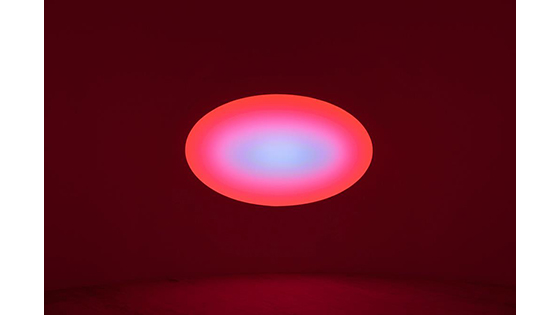My work is more about your seeing than it is about my seeing, although it is a product of my seeing. I’m also interested in the sense of presence of space; that is space where you feel a presence, almost an entity—that physical feeling and power that space can give. James Turrell
From November 22, 2019 to March 29, 2020,Museo Jumex presents a survey of the internationally acclaimed arti James Turrell (USA, b.1943). The exhibition features new works from Turrell’s most important series, spanning two floors of Museo Jumex’s galleries. Each installation is a carefully controlled environment in which light is formed and experienced.
Using light as his medium, saturated elds of color take on a physical presence. Through a scientific understanding of light’s affects and a singular artistic vision, Turrell creates wordless meditations on time and space that are as relevant today as they have been throughout human history. Extending beyond the physical spaces of a gallery or museum, the artist has created monumental structures that makes the skies and heavenly bodies seem tangible to the viewer.
Each body of work in the exhibition has been juxtaposed by a quotation from diverse sources that offer a poetic understanding of Turrell’s influences.
The first floor gallery presents Amesha Spentas one of James Turrell’s Ganzfeld installations that subsume the visitor in a field of color. As light modulates through a sequence of changing colors and effects, space transforms and dissolves around the viewer, the installation is designed to eliminate the viewer’s depth perception and provoke different ways of seeing.
On the second floor the exhibition continues with a selection of installations, prints, photographs, models and holograms that survey Turrell’s broad-ranging practice.
The exhibition is introduced by the First Light prints that capture the various forms made from light from Turrell’s Projection Pieces. A projection piece installation follows, marking one of the artists’ earliest experiments with using pure light as a medium to transform space. The Double Shallow Space (Atman) and Wedgework (Spenta Mainyu)installations date from the same period.
The exhibition continues with a selection of photographs and models that document Turrell’s Roden Crater project. Aerial views of the crater portray Turrell’s view of the crater from his percpective as an experienced pilot, an important influence on his understanding of light. The models allow visitors to envisage the point of view of looking out from Roden Crater’s chambers towards the sky. Further works include Turrell’s use of recent technology, including holograms, a natural medium for the artist to explore as light seems to take on a presence in space. The Curved Elliptical Glass(Gathas) installation is among Turrell’s most recent body of works, and its slow transformation of color has been likened by the artist to musical scores.
James Turrell: Passages of Light is organized by Kit Hammonds, Chief Curator, and Adriana Kuri Alamillo, Curatorial Assistant, Museo Jumex.
In order to preserve the intimate, meditative nature of James Turrell’s work, museum capacity will be limited during this exhibition. Please be aware that there may be delays for entry. Photography and video are not permitted within the exhibition.
JAMES TURRELL
James Turrell, considered one of the most important artist of the Southern California Light and Space movement, was born in Los Angeles in 1943 and attended Pomona College, where he studied art, art history, mathematics, perceptual psychology and astronomy. Turrell’s work has been widely acclaimed and exhibited since his first showing at the Pasadena Art Museum in 1967. His work has since been presented at major venues including the Stedelijk Museum, Amsterdam (1976); the Whitney Museum of American Art, New York (1980); the Israel Museum (1982); the Museum of Contemporary Art, Los Angeles (1984); MAK, Vienna (1998–99); the Mattress Factory, Pittsburgh (2002–03); and the Kunstmuseum Wolfsburg, Germany (2009– 10); the Solomon R. Guggenheim Museum, New York (2013) and was included in the54th Venice Biennale (2011).
MUSEO JUMEX
Museo Jumex is the Fundación Jumex Arte Contemporáneo’s main platform. It opened its doors to the public in November 2013 as an institution devoted to contemporary art, whose aim was not only to serve a broad and diverse public, but also to become a laboratory for experimentation and innovation in the arts. Through its exhibitions and public programs, Museo Jumex aspires to become a relevant in institution in the field of art by producing and coproducing original exhibitions and research, and familiarizing audiences with the concepts and contexts that inform current art practice. Through the use of critical and pedagogical tools, the museum’s educational programs further the institution’s commitment to build links between contemporary art and the public.
ADMISSION
General admission / $50 MXN
Mexican citizens / $30 MXN
Free for: Children under 15 / Students* / Senior citizens* /Teachers**with valid ID
Sundays free
HOURS
Tuesday–Sunday / 10 AM–8 PM Monday / Closed
PRESS CONTACTS
Ruth Ovseyevitzruth@fundacionjumex.org +52 (55) 5395 2618–107
Maricruz Garrido maricruz@fundacionjumex.org +52 (55) 5395 2615–103
JAMES TURRELL: PASSAGES OF LIGHT
GALLERIES 1 & 2
NOV.22.2019–MAR.29.2020
MUSEO JUMEX
MIGUEL DE CERVANTES SAAVEDRA 303,
COLONIA GRANADA, 11520, MEXICO CITY
FUNDACIONJUMEX.ORG






